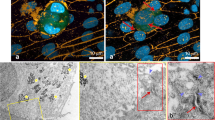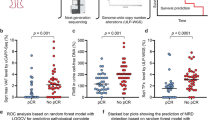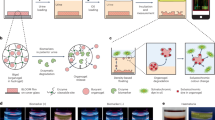Abstract
Aim:
Survivin molecular beacons can be used to detect bladder cancer cells in urine samples non-invasively. The aim of this study is to improve the specificity of detection of bladder cancer cells using survivin dual fluorescence resonance energy transfer molecular beacons (FRET MBs) that have fluorophores forming one donor-acceptor pair.
Methods:
Survivin-targeting dual fluorescence resonance energy transfer molecular beacons with unique target sequences were designed, which had no overlap with the other genes in the apoptosis inhibitor protein family. Human bladder cancer cell lines 5637, 253J and T24, as well as the exfoliated cells in the urine of healthy adults and patients with bladder cancer were examined. Images of cells were taken using a laser scanning confocal fluorescence microscope. For assays using dual FRET MBs, the excitation wavelength was 488 nm, and the emission detection wavelengths were 520±20 nm and 560±20 nm, respectively.
Results:
The human bladder cancer cell lines and exfoliated cells in the urine of patients with bladder cancer incubated with the survivin dual FRET MBs exhibited strong fluorescence signals. In contrast, no fluorescence was detected in the survivin-negative human dermal fibroblasts-adult (HDF-a) cells or exfoliated cells in the urine of healthy adults incubated with the survivin dual FRET MBs.
Conclusion:
The results suggest that the survivin dual FRET MBs may be used as a specific and non-invasive method for early detection and follow-up of patients with bladder cancer.
Similar content being viewed by others
Log in or create a free account to read this content
Gain free access to this article, as well as selected content from this journal and more on nature.com
or
References
Jemal A, Siegel R, Ward E, Hao Y, Xu J, Thun MJ . Cancer statistics, 2009. CA Cancer J Clin 2009; 59: 225–49.
Sasaki T, Horikawa M, Orikasa K, Sato M, Arai Y, Mitachi Y, et al. Possible relationship between the risk of Japanese bladder cancer cases and the CYP4B1 genotype. Jpn J Clin Oncol 2008; 38: 634–40.
Tsui KH, Juang HH, Lee TH, Chang PL, Chen CL, Yung BY . Association of nucleophosmin/B23 with bladder cancer recurrence based on immunohistochemical assessment in clinical samples. Acta Pharmacol Sin 2008; 29: 364–70.
Van Tilborg AA, Bangma CH, Zwarthoff EC . Bladder cancer biomarkers and their role in surveillance and screening. Int J Urol 2009; 16: 23–30.
Schultz IJ, Witjes JA, Swinkels DW, de Kok JB . Bladder cancer diagnosis and recurrence prognosis: comparison of markers with emphasis on survivin. Clin Chim Acta 2006; 368: 20–32.
Van Rhijn BW . Considerations on the use of urine markers for bladder cancer. Eur Urol 2008; 53: 880–1.
Zhao J, He D, He H, Li L, Zhang LL, Wang XY . Primary application study in early diagnosis of bladder cancer by survivin molecular beacons. Urology 2007; 70: 60–4.
Zhao J, Wang ZQ, Wang XY, Yang XJ, He D . Preliminary study of diagnostic utility of molecular beacons in bladder cancer. Urology 2010; 76: 512–8.
Chen AK, Behlke MA, Tsourkas A . Avoiding false-positive signals with nuclease-vulnerable molecular beacons in single living cells. Nucleic Acids Res 2007; 35: e105.
Krusinski T, Ozyhar A, Dobryszycki P . Dual FRET assay for detecting receptor protein interaction with DNA. Nucleic Acids Res 2010; 38: e108.
Santangelo PJ, Nix B, Tsourkas A, Bao G . Dual FRET molecular beacons for mRNA detection in living cells. Nucleic Acids Res 2004; 32: e57.
Yang L, Cao Z, Lin Y, Wood WC, Staley CA . Molecular beacon imaging of tumor marker gene expression in pancreatic cancer cells. Cancer Biol Ther 2005; 4: 561–70.
Wu KJ, Zeng J, Zhu GD, Zhang LL, Zhang D, Li L, et al. Silibinin inhibits prostate cancer invasion, motility and migration by suppressing vimentin and MMP-2 expression. Acta Pharmacol Sin 2009; 30: 1162–8.
Lekili M, Sener E, Demir MA, Temeltas G, Muezzinoglu T, Buyuksu C . Comparison of the nuclear matrix protein 22 with voided urine cytology in the diagnosis of transitional cell carcinoma of the bladder. Urol Res 2004; 32: 124–8.
Liu L, Zhang M, Zou P . Expression of PLK1 and survivin in non-Hodgkin's lymphoma treated with CHOP. Acta Pharmacol Sin 2008; 29: 371–5.
Vrooman OP, Witjes JA . Urinary markers in bladder cancer. Eur Urol 2008; 53: 909–16.
Weikert S, Christoph F, Schrader M, Krause H, Miller K, Muller M . Quantitative analysis of survivin mRNA expression in urine and tumor tissue of bladder cancer patients and its potential relevance for disease detection and prognosis. Int J Cancer 2005; 116: 100–4.
Wang Y, Wang N . FRET and mechanobiology. Integr Biol (Camb) 2009; 1: 565–73.
Ning S, Fuessel S, Kotzsch M, Kraemer K, Kappler M, Schmidt U, et al. siRNA-mediated down-regulation of survivin inhibits bladder cancer cell growth. Int J Oncol 2004; 25: 1065–71.
Acknowledgements
We thank Prof Xiao-hong FANG from the Institute of Chemistry, Chinese Academy of Sciences, for her helpful support. This work was supported by the National Natural Science Foundation of China (No 30672102).
Author information
Authors and Affiliations
Corresponding author
Rights and permissions
About this article
Cite this article
Wang, Zq., Zhao, J., Zeng, J. et al. Specific survivin dual fluorescence resonance energy transfer molecular beacons for detection of human bladder cancer cells. Acta Pharmacol Sin 32, 1522–1528 (2011). https://doi.org/10.1038/aps.2011.122
Received:
Accepted:
Published:
Issue date:
DOI: https://doi.org/10.1038/aps.2011.122



